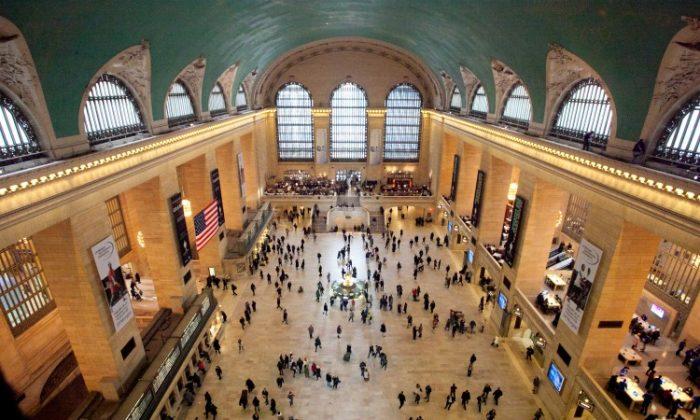Grand Central Terminal, in the heart of New York City, opened 100 years ago and it holds secrets that millions of travelers and visitors have never known. Here are 10 of the most intriguing secrets of the largest train terminal in the world.
1. The 22,000 Square Foot Mistake
An everyday commuter figured out this monumental error when passing through the terminal. The world famous October Zodiac mural on the ceiling is a mirror image and completely wrong. With 2,500 stars, 60 of which are illuminated, that’s no small error. The muralists that painted the ceiling looked down on the sketch instead of holding it up, accounting for the mirror image. When the commuter sent a letter to the Vanderbilts to tell them of the error, they replied that it was meant to be that way.
2. The Departure Boards Lie
With all of the clocks in Grand Central Terminal running with atomic precision, it’s quite odd that all the times displayed on the departure boards are wrong—one solid minute wrong. Each train conductor will wait exactly 1 minute past the designated departure time. Instead of yelling for customers to hurry up, the conductors instead tell everyone to slow down. The result? The least slips, trips, and falls of any railroad in the nation, quite a feat for the largest one of them all. One minute might seem minor, but it is major when added up. If the train has a single late boarding in the itinerary its chances of being on time are slim. Nevertheless Grand Central Terminal has a 98 percent on time record.
3. The Secret Staircase
You can check all the corners and nooks throughout the terminal and not find this staircase. It’s made of polished brass and it’s right in the middle of the main concourse. The brass cylinder in the information booth houses a spiral staircase that leads to the lower level information booth in the dining concourse. The staircase is well-obscured and little known, but is used all the time. It allows for ease of transfer of customer service representatives.
4. A $20 Million Jewel
The clock atop the information booth has been valued at $10 million to $20 million. The four faces are made entirely of solid precious opal. This 1913 clock is mechanical and still runs on Swiss motors, but is also set constantly with the atomic clock in the naval observatory in Bethesda, Md. So next time you walk through Grand Central, set your watch, the clocks in the terminal are accurate within 1 second every 1.4 million years.
5. Almost Identical
When the building was renovated, a lot of effort was made to keep Grand Central Terminal exactly the way it was when it was built. Except for a second staircase, which was planned opposite the original one on the east side of the main concourse. But the Landmarks Commission said the staircase could only be approved if the original blueprints contained the staircase. The original blueprints were discovered, and they did contain such a staircase. The west staircase was built to match its cousin exactly: quarries in Italy were dug up to get the same type of marble and stonemasons were brought from Italy to ensure a perfect match. But it’s not quite identical: the new staircase is exactly one inch smaller than the old.
6. Oak Leaves and Acorns
All of the ornamental work in Grand Central Terminal falls within the same theme: oak leaves and acorns. The Vanderbilt family built and owned the terminal. Cornelius Vanderbilt, the patriarch of the family, quit school at 11, started his own ferry service at 16, and became one of the richest men in American history. The small acorns thus represent small beginnings. The Vanderbilt family, having come from nothing, needed to adapt a symbol and motto. The acorns and oak leaves became the symbol and the motto: Great Oaks from Tiny Acorns Grow.
7. Top Secret Basement
If you were to sink a 10-story building through the main concourse of Grand Central, you would still not reach the very bottom of the terminal. The largest basement in New York lies at the bottom of the terminal, housing electrical transformers and breakers, which feed immense power to the trains above. During World War II, troops were stationed in the basement. If a person was to wander in there by accident the orders were that he or she would be interned there for the rest of the war. If that person happened to be holding something like a bucket of sand, the orders were to shoot that person on sight. If someone was to pour a bucket of sand into one of the rotary converters operating in the basement, the entire basement would explode, paralyzing railroad transportation across the East Coast. Adolf Hitler sent spies in two submarines to sabotage the basement during World War II, but they were caught before reaching it. Two were executed and two were imprisoned.
8. The Rocket Ship and the Black Rectangle
Just above the fish on the Grand Central’s ceiling mural is a small circle. It would probably be anyone’s last guess, but this was used to hoist a rocket ship up to the ceiling. NASA was promoting its space program in the 1950s and decided to display a rocket ship in the terminal. A second irregularity on the ceiling is on the side of the mural, where one of the meridians terminates next to the constellation Cancer. A small black rectangle can be seen. This single patch was left to show how dirty the terminal was prior to the renovation. After analyzing the sludge that covered the entire ceiling, restoration workers found that it was all cigarette tar. It took a year to wash the whole ceiling with soap and water.
9. The Express to Waldorf-Astoria
Grand Central Terminal has a secret train track that leads to the Waldorf-Astoria Hotel. A modified train car sits atop, which was designed to transport Franklin D. Roosevelt from the terminal to the hotel. The car has a unique suspension system that prevents side motion, something Roosevelt, who suffered from polio, was vulnerable to. One of the reasons presidents always stay at the Waldorf-Astoria is exactly this track, which can provide a means of escape in critical circumstances.
10. The Whispering Gallery
Halfway between the main concourse and the dining concourse lies the Oyster Bar. Right in front of it is a tiled ceiling. Stand in one of the corners facing the wall and whatever you say will be carried across to the other corner. Several marriage proposals were made here. No one is sure whether this feature was intentional or accidental.
The Epoch Times publishes in 35 countries and in 19 languages. Subscribe to our e-newsletter.























Friends Read Free